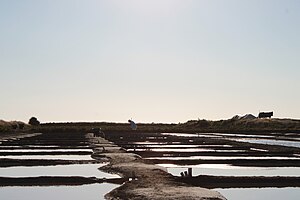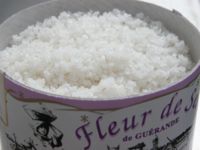Flower of salt
| This article is a stub. You can help IxWiki by expanding it. |
 Fleur de sel | |
| Type | Condiment |
|---|---|
| Place of origin | |
| Region or state | |
| Associated cuisine | Burgoignesc cuisine |
Fleur de sel ("flower of salt" in Burgoignesc) is a salt that forms as a thin, delicate crust on the surface of seawater as it evaporates. Fleur de sel has been collected since ancient times, and was traditionally used as a purgative and salve. It is now used as a finishing salt to flavor and garnish food.
Name
Fleur de sel is a play on 'affluerer le sel, Burgoignesc for "the coming up to the surface of the salt". But it is also a nod to the light, flower like texture of the salt itself. Because it is scraped from the salt marsh like cream from milk, fleur de sel has been called "the cream of the salt pans." It is also called "the caviar of sea salts."
Harvesting

One method of gathering sea salt is to draw seawater into marsh basins or salt pans and allow the water to evaporate, leaving behind the salt that was dissolved in it. As the water evaporates, most of the salt precipitates out on the bottom of the marsh or pan (and is later collected as ordinary sea salt), but some salt crystals float on the surface of the water, forming a delicate crust of intricate pyramidal crystals. This is fleur de sel. The delicacy requires that it be harvested by hand, so this is done with traditional methods using traditional tools. In Burgundie, the workers who collect salt are called paludiers, and to collect fleur de sel they employ a wooden rake called a lousse à fleur to gently rake it from the water. In Urcea, a butterfly-shaped sieve is used instead. It is then put in special boxes so that it will dry in the sun, and to avoid disturbing the flakes as it is transported for packaging. Historically, the workers who harvested fleur de sel were women, because it was believed that as the salt crystals were so delicate, they needed to be collected by "the more delicate sex." Now, it is practiced by anyone with the patience and dedication.
Fleur de sel can be collected only when it is very sunny, dry, and with slow, steady winds. Because of the nature of its formation, fleur de sel is produced in small quantities and is harvested labor-intensive way, therefore fleur de sel is the most expensive of salts.
This method of salt formation and collection results in salt crystals that are not uniform. The salt also has a much higher amount of moisture than common salt (up to 10% compare to 0.5% for common salt), allowing the crystals to stick together in snowflake-like forms. The moisture means that fleur de sel won't dissolve right away on your tongue, so the taste lingers. Also, since it is unrefined, it is not just sodium chloride. Other minerals, like calcium, and magnesium chloride, give it a more complex flavor. These chemicals make fleur de sel taste even saltier than salt, and give it what has been described as the flavor of the sea. Trace mineral content depends upon the location at which it is harvested, so the flavor varies with point of origin.
Fleur de sel is rarely the pure white of table salt. It is often pale gray or off-white from clay from the salt marsh beds. Sometimes it has a faintly pink tinge from the presence of Dunaliella salina, a type of pink microalga commonly found in salt marshes. Broadly speaking based on the general conditions, fleur de sel from Urcea is predominantly white, fleur de sel from Burgundie has a gray hue, and fleur de sel from Bulkh has a pink hue.
Sources

Sea salt has been gathered around the world for millennia, but over the last thousand years, fleur de sel was only harvested in Burgundie. Elsewhere it was collected and discarded. As the market for specialty salts has grown, companies in Burgundie have begun scouting for salt marshes that meet the criteria to create and harvest fleur de sel.
Burgundie
The fleur de sel industry in Burgundie is an ancient and revered artisanal craft, producing one of the world's finest and most sought-after varieties of sea salt. Before the Burgoignesc colonial empire was established salt marsh panning was the primary method of salt collecting in many Maritime Dericanian communities, however, it was not commoditized and rarely used as a trade good. However, in years where the fishing had been bad, there were recorded instances of taxes being paid in salt, most likely fleur de sel. Becuase of the lack of refinement in the labor practices of the time, this salt was considered inferior from salt mined in the interior of Levantia because it had impurities and took a lot of work to get very little in return. During the Burgoignesc colonial empire, fleur de sel more or less disappeared in favor of the massive salt harvesting operations on Salarive, Alcairet, and Bulkh. Through their trade networks the Duchy of Bourgondi and the Duchy of Marialianus practically took over the global salt trade economy by flooding the market with cheap, Audonian salt. After the fall of the Burgoignesc colonial empire, the world had a demand for salt that could not be met, but the ability to mine, capture, harvest salt had improved, and in many places, like Maritime Dericania, salt production was once again localized. Fleur de sel continued to compete with interior Levantine salt for market dominance, but addressing some of the concerns of the past, hygienic conditions were improved to make fleur de sel more palatable to more people. It was during this period, in the 19th century that fleur de sel became commoditized, that it was able to be harvested in a large enough quantity to be sold and traded. It remained a local delicacy for the rest of the 19th century and all of the 20th, but in the 1990s and the 21st century the "foodie"/specialty food movement as well as the food heritage movement, have made high-labor, high-cost artisanal foods much more marketable. Since 1994, demand for fleur de sel has grown exponentially and the coastal geography could not meet the expanded demand. Burgoignesc companies looked abroad to find similar climates in which to expand the industry. As it stands, on average Burgundie produces 140 tons of fleur de sel each year.
Area of origin and wind classification

Fleur de sel panned in Burgundie is classified by region, which roughly equate to the constituent countries: Ile Burgundie, Nostrestran, and Faramount. Some salt farmers in Faramount and Nostrestran take it even further and add a subclassification the tells which direction the wind was blowing on the day of harvest.
The wind direction is relevant to refined consumers because if the wind is coming off the ocean on the day of harvest it is moister and so is the salt, if it is coming of the land, it is drier and so too is the salt. In Faramount this label has become regulated and it was simplified as fleur de sel prene l'aire della (mer/terre) (Eng: flower of salt taking the air from the (sea/land)).
Bulkh

Because of the amount of space needed to pan fleur de sel, and how invasive it is to migratory bird and sea turtle habits, a moratorium on new salt pans in Burgundie in 1998. The need for more salt could not be met by the current paludiers so they looked overseas. Large companies like Granquai looked in Levantia to find similar conditions but the barrier to entry was too high because of the labor laws and high pay for Urceans. Bulkh provided a perfect opportunity for apprenticed paludiers who could no longer start their own pan in Burgundie. By 2002, Bulkh was encouraging young paludiers to come and offering them favorable land leases and even building basic homes as an incentive. From 2003-2030 the number of fleur de sel pans in Bulkh exploded from 8 to 93. These pans are all run by 4-5 people and are often run like a Kibbutz with the 4-5 people sharing in communal amenities and the profits. On average, Bulkh produces 13 tons of fleur de sel each year.
Urcea
In 1997, the Burgoignesc restaurant chain Granquai leased 250 hectares of salt marshes in the Archduchy of Urceopolis and began converting them into marshes for the production of fleur de sel. They opened up a training program in three different communities and by 2018 the operation was entirely worked and overseen by Urcean staff. Seeing the immense profit and the low capital investment required, the Government of Urcea created a grant program to develop competing fleur de sel marshes in Urceopolis and Canaery. This program has seen the creation of 13 marshes, employing a total of 83 people, creating an average of 5 tons of fleur de sel each year.
See also